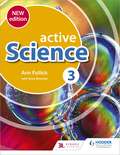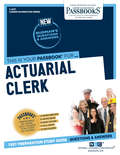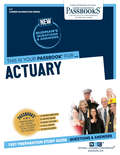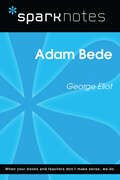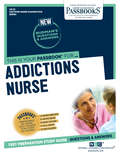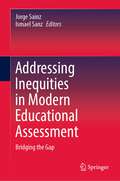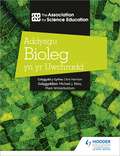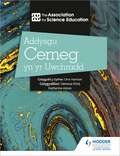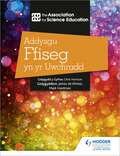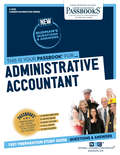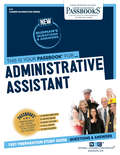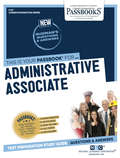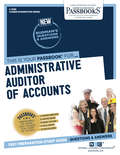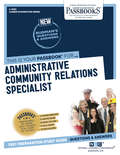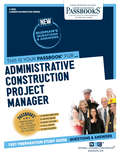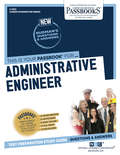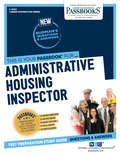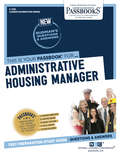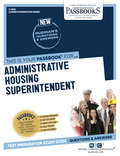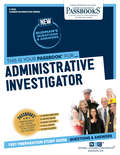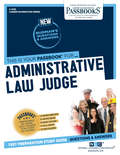- Table View
- List View
Active Science 3 new edition (Active Science #3)
by Ann FullickBuild and assess your students' Science knowledge, understanding and skills through better learning techniques, ensuring a solid foundation for further science study.- Confidently meet the requirements of the Trinidad & Tobago, Barbados, Guyana and OECS curricula and CXC's CCSLC syllabus with detailed mapping grids available for free online. - Inspire students to progress with this contemporary take on Science that includes topics such as environmental science and green issues.- Engage students through an active learning approach with hands-on activities to promote learning through practice.- Prepare students for moving up to CSEC® level science with activities developed to bridge the gap between lower secondary and CSEC® level.
Actuarial Clerk: Passbooks Study Guide (Career Examination Series #C-2417)
by National Learning CorporationThe Actuarial Clerk Passbook® prepares you for your test by allowing you to take practice exams in the subjects you need to study. It provides hundreds of questions and answers in the areas that will likely be covered on your upcoming exam, including but not limited to: algebraic reasoning; understanding information presented in tables; basic actuarial reasoning; and other related areas.
Actuary: Passbooks Study Guide (Career Examination Series #C-7)
by National Learning CorporationThe Actuary Passbook® prepares you for your test by allowing you to take practice exams in the subjects you need to study. It provides hundreds of questions and answers in the areas that will likely be covered on your upcoming exam, including but not limited to: general mathematics; specialized actuarial mathematics; all phases of the insurance business; understanding and interpreting written material; and other related areas.
Adam Bede (SparkNotes Literature Guide Series)
by SparkNotesAdam Bede (SparkNotes Literature Guide) by Geoge Elliot Making the reading experience fun!Created by Harvard students for students everywhere, SparkNotes is a new breed of study guide: smarter, better, faster.Geared to what today's students need to know, SparkNotes provides:chapter-by-chapter analysisexplanations of key themes, motifs, and symbolsa review quiz and essay topicsLively and accessible, these guides are perfect for late-night studying and writing papers.
Addictions Nurse: Passbooks Study Guide (Certified Nurse Examination Series)
by National Learning CorporationThe Certified Nurse Examination Series prepares individuals for licensing and certification conducted by the American Nurses Credentialing Center (ANCC), the National Certification Corporation (NCC), the National League for Nursing (NLN), and other organizations. The Addictions Nurse Passbook® provides a series of informational texts as well as hundreds of questions and answers in the areas that will likely be covered on your upcoming exam.
Addressing Inequities in Modern Educational Assessment: Bridging the Gap
by Jorge Sainz Ismael SanzThis edited book focuses on the central and up-to-date issues that represent some of the most relevant challenges and limitations of International Learning Assessments (ILSAs). It specifically sheds light on the general effects of the discontinuation of face-to-face education on students at diverse academic levels during the COVID-19 pandemic.Through the lens of the most relevant experts of the field, it highlights the asymmetric effects on students based on family income, education level, or employment, imposing a heavy toll on those with less resources.It raises issues regarding the impact on the mental health of students and education professionals due to school closures. Modern education is shifting its focus from just scores to detailed, qualitative feedback. Such comprehensive insights help students identify both strengths and growth areas, making assessments more constructive.This book is aimed for researchers in the field of educational assessments, graduate and postgraduate students, policy makers, and anyone interested in making informed decisions regarding ILSAs. COVID-19 brought immense educational challenges, it also presented an unprecedented opportunity: to reassess and reform existing systems, steering towards assessments that are both fair and empowering.
Addysgu Bioleg yn yr Uwchradd (Teaching Secondary Biology 3rd Edition Welsh Language edition)
by The Association EducationEnhance your teaching with expert advice and support for Key Stages 3 and 4 Biology from the Teaching Secondary series - the trusted teacher's guide for NQTs, non-specialists and experienced teachers.Written in association with ASE, this updated edition provides best practice teaching strategies from academic experts and practising teachers.- Refresh your subject knowledge, whatever your level of expertise- Gain strategies for delivering the big ideas of science using suggested teaching sequences- Engage students and develop their understanding with practical activities for each topic- Enrich your lessons and extend knowledge beyond the curriculum with enhancement ideas- Improve key skills with opportunities to introduce mathematics and scientific literacy highlighted throughout- Support the use of technology with ideas for online tasks, video suggestions and guidance on using cutting-edge software- Place science in context; this book highlights where you can apply science theory to real-life scenarios, as well as how the content can be used to introduce different STEM careersAlso available: Teaching Secondary Chemistry, Teaching Secondary Physics
Addysgu Bioleg yn yr Uwchradd (Teaching Secondary Biology 3rd Edition Welsh Language edition)
by The Association EducationEnhance your teaching with expert advice and support for Key Stages 3 and 4 Biology from the Teaching Secondary series - the trusted teacher's guide for NQTs, non-specialists and experienced teachers.Written in association with ASE, this updated edition provides best practice teaching strategies from academic experts and practising teachers.- Refresh your subject knowledge, whatever your level of expertise- Gain strategies for delivering the big ideas of science using suggested teaching sequences- Engage students and develop their understanding with practical activities for each topic- Enrich your lessons and extend knowledge beyond the curriculum with enhancement ideas- Improve key skills with opportunities to introduce mathematics and scientific literacy highlighted throughout- Support the use of technology with ideas for online tasks, video suggestions and guidance on using cutting-edge software- Place science in context; this book highlights where you can apply science theory to real-life scenarios, as well as how the content can be used to introduce different STEM careersAlso available: Teaching Secondary Chemistry, Teaching Secondary Physics
Addysgu Cemeg yn yr Uwchradd (Teaching Secondary Chemistry 3rd Edition Welsh Language edition)
by The Association EducationEnhance your teaching with expert advice and support for Key Stages 3 and 4 Chemistry from the Teaching Secondary series - the trusted teacher's guide for NQTs, non-specialists and experienced teachers.Written in association with ASE, this updated edition provides best practice teaching strategies from academic experts and practising teachers.- Refresh your subject knowledge, whatever your level of expertise- Gain strategies for delivering the big ideas of science using suggested teaching sequences- Engage students and develop their understanding with practical activities for each topic- Enrich your lessons and extend knowledge beyond the curriculum with enhancement ideas- Improve key skills with opportunities to introduce mathematics and scientific literacy highlighted throughout- Support the use of technology with ideas for online tasks, video suggestions and guidance on using cutting-edge software- Place science in context; this book highlights where you can apply science theory to real-life scenarios, as well as how the content can be used to introduce different STEM careersAlso available: Teaching Secondary Biology, Teaching Secondary Physics
Addysgu Cemeg yn yr Uwchradd (Teaching Secondary Chemistry 3rd Edition Welsh Language edition)
by The Association EducationEnhance your teaching with expert advice and support for Key Stages 3 and 4 Chemistry from the Teaching Secondary series - the trusted teacher's guide for NQTs, non-specialists and experienced teachers.Written in association with ASE, this updated edition provides best practice teaching strategies from academic experts and practising teachers.- Refresh your subject knowledge, whatever your level of expertise- Gain strategies for delivering the big ideas of science using suggested teaching sequences- Engage students and develop their understanding with practical activities for each topic- Enrich your lessons and extend knowledge beyond the curriculum with enhancement ideas- Improve key skills with opportunities to introduce mathematics and scientific literacy highlighted throughout- Support the use of technology with ideas for online tasks, video suggestions and guidance on using cutting-edge software- Place science in context; this book highlights where you can apply science theory to real-life scenarios, as well as how the content can be used to introduce different STEM careersAlso available: Teaching Secondary Biology, Teaching Secondary Physics
Addysgu Ffiseg yn yr Uwchradd (Teaching Secondary Physics 3rd Edition Welsh Language edition)
by The Association EducationEnhance your teaching with expert advice and support for Key Stages 3 and 4 Physics from the Teaching Secondary series - the trusted teacher's guide for NQTs, non-specialists and experienced teachers.Written in association with ASE, this updated edition provides best practice teaching strategies from academic experts and practising teachers.- Refresh your subject knowledge, whatever your level of expertise- Gain strategies for delivering the big ideas of science using suggested teaching sequences- Engage students and develop their understanding with practical activities for each topic- Enrich your lessons and extend knowledge beyond the curriculum with enhancement ideas- Improve key skills with opportunities to introduce mathematics and scientific literacy highlighted throughout- Support the use of technology with ideas for online tasks, video suggestions and guidance on using cutting-edge software- Place science in context; this book highlights where you can apply science theory to real-life scenarios, as well as how the content can be used to introduce different STEM careersAlso available: Teaching Secondary Chemistry, Teaching Secondary Biology
Addysgu Ffiseg yn yr Uwchradd (Teaching Secondary Physics 3rd Edition Welsh Language edition)
by The Association EducationEnhance your teaching with expert advice and support for Key Stages 3 and 4 Physics from the Teaching Secondary series - the trusted teacher's guide for NQTs, non-specialists and experienced teachers.Written in association with ASE, this updated edition provides best practice teaching strategies from academic experts and practising teachers.- Refresh your subject knowledge, whatever your level of expertise- Gain strategies for delivering the big ideas of science using suggested teaching sequences- Engage students and develop their understanding with practical activities for each topic- Enrich your lessons and extend knowledge beyond the curriculum with enhancement ideas- Improve key skills with opportunities to introduce mathematics and scientific literacy highlighted throughout- Support the use of technology with ideas for online tasks, video suggestions and guidance on using cutting-edge software- Place science in context; this book highlights where you can apply science theory to real-life scenarios, as well as how the content can be used to introduce different STEM careersAlso available: Teaching Secondary Chemistry, Teaching Secondary Biology
Adhunik Karyaliyin Vyavasthapan-1 First Semester FYB.COM New NEP Syllabus - SPPU: आधुनिक कार्यालयीन व्यवस्थापन-1 प्रथम सत्र एफ.वाय.बी.कॉम नवीन एन.इ.पी. अभ्यासक्रम - सावित्रीबाई फुले पुणे यूनिवर्सिटी
by Dr Dnyandev Laxman Nitve Dr Rupali Bipin Sheth Dr Yashodhan Manohar Mithare'आधुनिक कार्यालयीन व्यवस्थापन-1' हे पुस्तक सावित्रीबाई फुले पुणे विद्यापीठाच्या एफ.वाय.बी.कॉम प्रथम सत्राच्या नवीन एन.इ.पी. अभ्यासक्रमानुसार तयार केलेले आहे. या पुस्तकात कार्यालय व्यवस्थापनाच्या विविध पैलूंवर सखोल माहिती दिली आहे. प्रमुख विषयांमध्ये आधुनिक कार्यालयीन सेवा, कार्यालय स्वयंचलन (ऑटोमेशन), कार्यालयीन कार्यपद्धती आणि कार्यालयीन कामाचे मानकीकरण, तसेच कार्यालयीन नियमावली आणि मानक कार्यपद्धती यांचा समावेश आहे. या पुस्तकाचे लेखक डॉ. यशोधन मनोहर मिठारे, डॉ. ज्ञानदेव लक्ष्मण निटवे, आणि डॉ. रुपाली बिपीन शेठ आहेत. पुस्तकाची पहिली आवृत्ती जून 2024 मध्ये प्रकाशित झाली असून, त्यात एकूण 170 पृष्ठे आहेत. पुस्तकातील प्रकरणांमध्ये आधुनिक कार्यालयीन सेवा, कार्यालय स्वयंचलन, कार्यालयीन कार्यपद्धती आणि कार्यालयीन कामाचे मानकीकरण, तसेच कार्यालयीन नियमावली आणि मानक कार्यपद्धती यांचा समावेश आहे.
Administrative Accountant: Passbooks Study Guide (Career Examination Series)
by National Learning CorporationThe Administrative Accountant Passbook® prepares you for your test by allowing you to take practice exams in the subjects you need to study. It provides hundreds of questions and answers in the areas that will likely be covered on your upcoming exam, including but not limited to: overseeing financial functions; providing information and advice; management control; preforming and directing financial work; report writing; communication skills; and other related areas.
Administrative Assistant: Passbooks Study Guide (Career Examination Series #C-1848)
by National Learning CorporationThe Administrative Assistant Passbook® prepares you for your test by allowing you to take practice exams in the subjects you need to study. It provides hundreds of questions and answers in the areas that will likely be covered on your upcoming exam, including but not limited to: clerical operations using letters and numbers; office management and record keeping; preparing written material; public contact principles and practices; and other related areas.
Administrative Associate: Passbooks Study Guide (Career Examination Series #C-3425)
by National Learning CorporationThe Administrative Associate Passbook® prepares you for your test by allowing you to take practice exams in the subjects you need to study. It provides hundreds of questions and answers in the areas that will likely be covered on your upcoming exam.
Administrative Auditor of Accounts: Passbooks Study Guide (Career Examination Series)
by National Learning CorporationThe Administrative Auditor of Accounts Passbook® prepares you for your test by allowing you to take practice exams in the subjects you need to study. It provides hundreds of questions and answers in the areas that will likely be covered on your upcoming exam, including but not limited to: general accounting and auditing; understanding and interpreting written material; understanding and interpreting tabular material; supervision, and more.
Administrative Community Relations Specialist: Passbooks Study Guide (Career Examination Series)
by National Learning CorporationThe Administrative Community Relations Specialist Passbook® prepares you for your test by allowing you to take practice exams in the subjects you need to study. It provides hundreds of questions and answers in the areas that will likely be covered on your upcoming exam, including but not limited to: Problem solving and decision making; Management control; Interpersonal skills; Staff development; Written comprehension; and more.
Administrative Construction Project Manager: Passbooks Study Guide (Career Examination Series)
by National Learning CorporationThe Administrative Construction Project Manager Passbook® prepares you for your test by allowing you to take practice exams in the subjects you need to study. It provides hundreds of questions and answers in the areas that will likely be covered on your upcoming exam, including but not limited to: problem solving and decision making; supervisory and management control including delegation, planning, organizing, and prioritizing; development of subordinates; written comprehension; written communication; mathematical and statistical analysis; standards of proper employee conduct; and more.
Administrative Engineer: Passbooks Study Guide (Career Examination Series #C-1271)
by National Learning CorporationThe Administrative Engineer Passbook® prepares you for your test by allowing you to take practice exams in the subjects you need to study. It provides hundreds of questions and answers in the areas that will likely be covered on your upcoming exam, including but not limited to: employee management relations; evaluation of technical problems; operation of governmental agencies; management techniques; engineering subjects; and more.
Administrative Housing Inspector: Passbooks Study Guide (Career Examination Series)
by National Learning CorporationThe Administrative Housing Inspector Passbook® prepares you for your test by allowing you to take practice exams in the subjects you need to study. It provides hundreds of questions and answers in the areas that will likely be covered on your upcoming exam, including but not limited to: management techniques; agency inspection procedures, rules and regulations and policy; assessment of condition of premises in order to determine the extent to which requirements are met; preparation of reports and correspondence; standards of proper employee ethical conduct; and more.
Administrative Housing Manager: Passbooks Study Guide (Career Examination Series)
by National Learning CorporationThe Administrative Housing Manager Passbook® prepares you for your test by allowing you to take practice exams in the subjects you need to study. It provides hundreds of questions and answers in the areas that will likely be covered on your upcoming exam, including but not limited to: communications and human relations; administration (including supervision and management functions, decision making and techniques of apportioning time) relevant to housing management; personnel management techniques and rules, and training methods and techniques; reading comprehension and interpretation of pertinent material; budget preparation and administration; government operations and relationships; and more.
Administrative Housing Superintendent: Passbooks Study Guide (Career Examination Series)
by National Learning CorporationThe Administrative Housing Superintendent Passbook® prepares you for your test by allowing you to take practice exams in the subjects you need to study. It provides hundreds of questions and answers in the areas that will likely be covered on your upcoming exam, including but not limited to: administration; supervision; personnel management techniques and rules; reading comprehension; preparing written material; understanding and interpreting written material; and other related areas.
Administrative Investigator: Passbooks Study Guide (Career Examination Series)
by National Learning CorporationThe Administrative Investigator Passbook® prepares you for your test by allowing you to take practice exams in the subjects you need to study. It provides hundreds of questions and answers in the areas that will likely be covered on your upcoming exam, including but not limited to: analysis and problem solving; management control; knowledge and application of rules, laws and procedures pertaining to investigations; preparing written material; understanding and interpreting written material; and other related areas.
Administrative Law Judge: Passbooks Study Guide (Career Examination Series)
by National Learning CorporationThe Administrative Law Judge Passbook prepares you for your test by allowing you to take practice exams in the subjects you need to study. It provides hundreds of questions and answers in the areas that will likely be covered on your upcoming exam, including but not limited to: state and federal public assistance programs; administrative hearing proceedings; court decisions interpreting the powers of administrative boards and agencies; principles and theories of administrative law and the judicial review of administrative actions; legal terms and forms in common use in administrative proceedings; and more.
